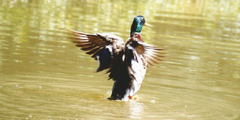Finally sun: spring fever with the ducks
 You do not really have to say anything about such a picture of a mallard-dwarf than: finally, sun, warmth and Spring feelings! And of course the spring feelings do not come awake with the ducks, because while true-to-the-line ducks mate in the fall, migratory birds do not start until spring.
You do not really have to say anything about such a picture of a mallard-dwarf than: finally, sun, warmth and Spring feelings! And of course the spring feelings do not come awake with the ducks, because while true-to-the-line ducks mate in the fall, migratory birds do not start until spring.
In the mallards, not only a drake buzzes for a duck Lady, it is in the group to the favor of female ducks. Imposing, the colorful feathered drakes plump up and show what their wings have to offer. However, they raise the wings just a little, because you have to pick up one or the other surprise effect: Finally, mallards can be almost 60 inches tall and bring it to a wingspan of up to 95 centimeters. Speaking of plumage: A mallard is well protected against the cold thanks to plumage, because she has about 10,000 downs and feathers, according to Wikipedia.
Her name Mallard has this country-wide, common duck species due to their breeding behavior. Namely, the nests of stalks are preferably built on elevated and sticky locations, such as in a hollowed trunk or in a pasture. If such a popular breeding site is lacking, the ducks also take with shrubbery or bank vegetation as a nesting site. The breeding season begins - and then you notice again the punctuality of spring fever - from March. Every day, the inconspicuous light brown dyed female lays an egg and for each clutch around 15 eggs can come together. They are then incubated for 25 to 28 days. Within the first twelve hours of life, the chicks are already drawn to the water and they can swim without swimming lessons.
However, there is still a lot to learn, so the little ones stay with their mother for about 50 to 60 days teaches a lot and of course protects them. Finally, there are predators, such as foxes, martens, rats, raccoons or birds of prey. It also learns what to eat and this includes plants in and on the water, fruits, seeds and in between, it may sometimes be a frog, a little fish, a tadpole, a small crab or even a worm or a snail. Exercise also requires hunting and this includes dive training, because many delicacies are under water and ducks must be able to roam in order to get there. Gründeln is the well-known and in a nursery rhyme described diving style: head under water, tail in the height '. Foraging ducks are also found on fields on the way - practical, if you make a trip and can nibble on a potato, nut, glans or a grain kernel to strengthen. Of course, the mallard likes to live close to the water - what otherwise? - and she is very common with us. Nevertheless, she is also a global player. Europe, North America, Asia, New Zealand, Australia or North Africa - the mallard is a true world conqueror. Whether land or city - the important thing is that there is a lake, pond or moat. Whether a mallard flies through life as a migratory bird depends on the climate: the colder it is, the more the mallard chooses to live as a migratory bird wintering in warmer climes. But where the winter cold can not strike, mallards also like to make themselves comfortable and save the flight to the south. Mallards are especially comfortable in company and therefore it is not surprising that there is always something to talk about in a sociable round with lots of Quäk-Qäk and Wi-Wi. Text/Photo: Marion Friedl